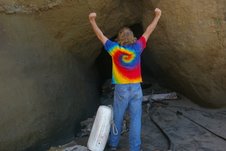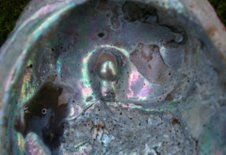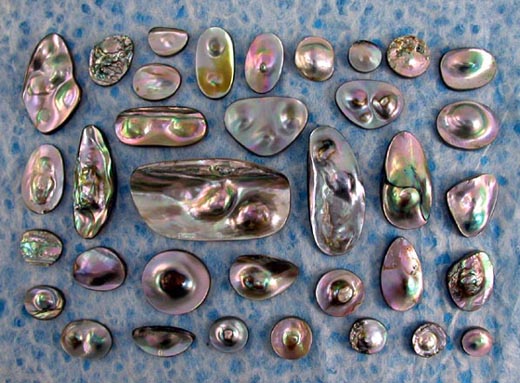Invisible Things
 Story by John Vonderlin
Story by John Vonderlin

Mabe’s made from Natural Abalone Blister Pearls: Offered here is the culmination of a search spanning more than 15 years. During this time I have sought a rare and beautiful jewel that has very seldom found it’s way into the jewelry market. These years of effort have been successful. I have been so fortunate as to obtain a sufficient, though limited, number of natural, Abalone, Blister Pearls to offer for sale. Along the way, I learned the techniques to transform them into beautiful, often-exquisite jewels by processing them into Mabe’ Pearls. I believe that these jewels speak for themselves. The size, color, luster and form of these gems spans a wide range. I have a few that are of size and quality that can only be judged as truly exceptional. These generally take and merit quite a bit more time and effort to process and will be posted and offered on this site as they are finished.
You will find that these Abalone Mabe’s from the wild differ substantially from the Abalone Mabe’s made from cultured (artificially nucleated and grown in farmed Abalone) blister pearls. Cultured blister pearls are grown by gluing synthetic or shell hemispheres onto the inside of the mollusk’s shell. The creature then covers it with alternating layers of conchiolin, a binding protein, and nacre, the beautiful material that makes up pearls and mother of pearl shells. These are cultured in a limited number of predictable shapes. The Mabe’s from wild Abalone Blister Pearls offered here were grown in the sea by free-living, wild abalone’s with no human intervention whatsoever. They were formed by the mollusk’s self defense processes that cover and protect it from naturally occurring parasites or other irritants. The forms taken by the wild Abalones vary greatly in shape, size and character and most are quite unique and very beautiful. The mabe’s offered here are from the Pacific shores of North America and generally feature more delicate shades of aqua, rose, pink, green and sometimes golden yellow. The Black Abalone of which I have a very few blister pearls have the most delicate coloring of all and the Green Abalone, of which I also have a few, tend more to darker blues, greens, deeper rose and even some black. Like natural pearls or natural pearl products of any kind, these are some of the rarest gem materials to be found today. Over-harvest and pollution have taken their toll and the pearl-producing mollusks that form natural pearls are now extremely scarce. The once plentiful native abalones that grow along the pacific coastline have become so scarce and, in some cases, rare and endangered, that there is very little harvest allowed, none of it commercial. The abalone blister pearls that I offer are from collections and other select sources that were harvested back when it was legal to do so and they were not thought to be in danger.
Mabe pearls, whether they are created from natural or cultured blister pearls are a constructed jewel. Like all natural blister-pearls, those of the abalone must be processed into mabe’ pearls to make them robust for wearing in jewelry. To do this, the shell behind the pearls must be ground off, then whatever is to be found inside must be removed and replaced with a polymer compound. This gives it the necessary support to be worn without concern that it will be damaged in ordinary, everyday use. The back of the shell is then replaced with mother of pearl or other gem material. In some cases, when the pearl warrants it, the back may be constructed of semi-precious-gem intarsia. Finally, the sides and back are polished to a high luster like the front of the pearl. They are then ready to be set in jewelry.
